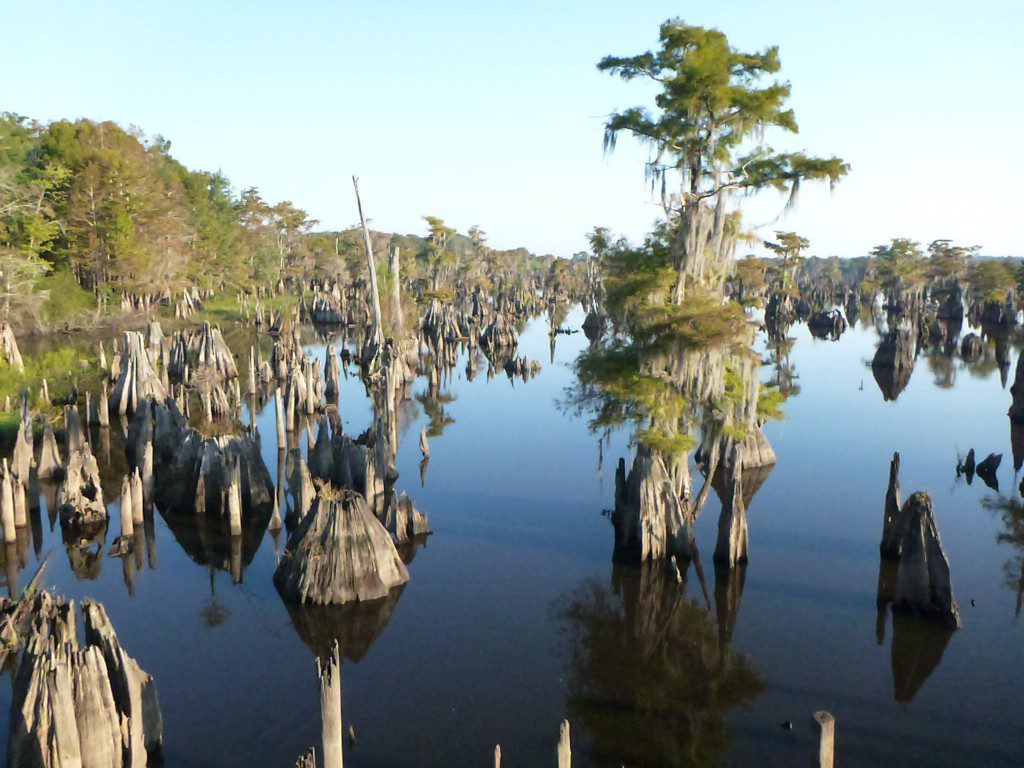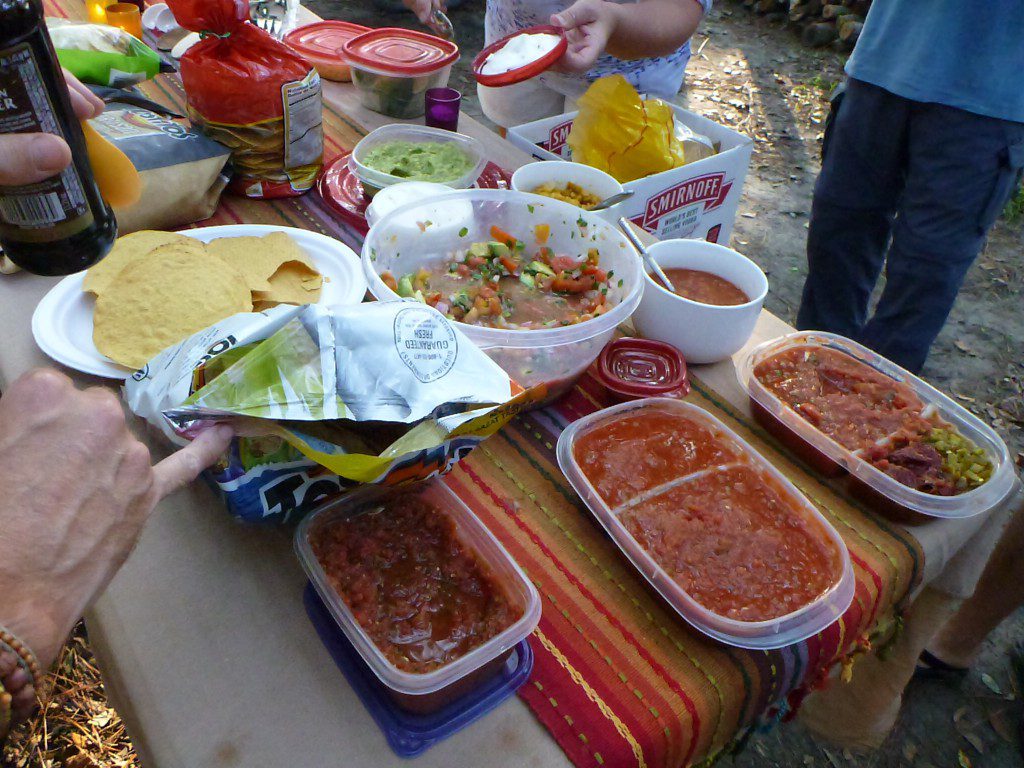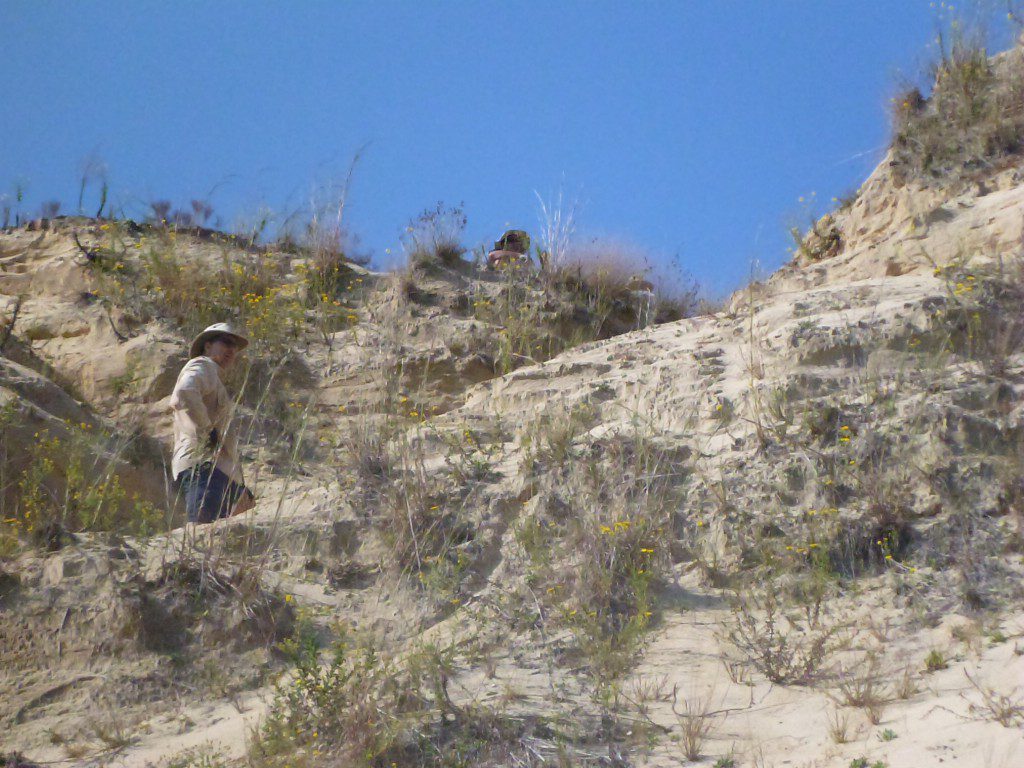Rob Diaz de Villegas WFSU-TV
The sounds I hear in my tent every morning sort of define where we slept that night. Alum Bluff had the barred owls, Estiffinulga had the rooster and boats launching. Dead Lakes had a low grinding noise that Doug Alderson identified by the campfire after our Wewa chinese dinner. Pine beetles were eating one of the pine trees we were sleeping under. He told Bob, the campsite caretaker, as the tree had to be removed before the beetles spread to other trees.
 Before we started the day’s paddling, we stopped to look at the Dead Lakes. A sand bar from the Apalachicola River trapped the Chipola River, killing thousands of trees. These trees are still there. There was a discussion yesterday about some or all of us paddling through the dead lakes into the Chipola, which meets up with the Apalachicola a few miles downstream. In the end, we decided to stay on the Apalach. As beautiful as the Dead Lakes are, we don’t want to miss any part of the River.
Before we started the day’s paddling, we stopped to look at the Dead Lakes. A sand bar from the Apalachicola River trapped the Chipola River, killing thousands of trees. These trees are still there. There was a discussion yesterday about some or all of us paddling through the dead lakes into the Chipola, which meets up with the Apalachicola a few miles downstream. In the end, we decided to stay on the Apalach. As beautiful as the Dead Lakes are, we don’t want to miss any part of the River.
This is where the bluffs start getting much shorter and the sand bars get fewer and further between. In fact, for our first break we forewent a restfull sit in the sand for a scramble up Sand Mountain. Sand Mountain was created by the Army Corps of Engineer as they dredged the river. All that sand that was sitting at the bottom of the river was piled up into a 50-60 feet high mound. It takes patience to climb, using hands and feet as the mountain sucked them in. It was a great view if the river.
Today, Alex Reed and Bryan Desloge rocket off ahead of the pack. Me, I’m still slowing down to shoot things. I envy Jennifer Portman of the Tallahassee Democrat. She’s in a tandem with Chris Robertson, who paddles on without complaint while she stops to take notes, tweet, or take photos. It reduces the risk that you bump someone or get your kayak turned around while changing a battery. Of course, Doug Alderson is taking notes and photos for his Visit Tallahassee blog and possibly for the next book he does on paddling (he’s currently working on a book about the Seminole Wars). He doesn’t seem to have as many problems as I do. He, along with the majority of the paddlers, have guided kayak tours at the Wilderness Way. They know what they’re doing. Me, I’m happy to be here with them and pick up the occasional tip.
Our camp site is down Owl Creek. The bluffs are lower in this part of the river and there are fewer sandbars. I’m not sure what the correlation is. But it does mean we have to paddle a mile-and-a-half off of the river to sleep tonight. It’s a great creek, with a lot of cypress trees including a small island where you can paddle between them. When we get to the camp site, Alex and Bryan say they’ve been there an hour-and-a-half.
 Our support team was lights out, with Fred Borg procuring campsites and bringing homemade salsa. Eddie Lueken and her husband Mitch Ross brought us quite a spread. In addition to the delicious machaca (a beef dish), Eddie had made chicken and bean enchiladas, guacamole, and pico de gallo. All home made. This support team has really gone above and beyond for us. Thank you!
Our support team was lights out, with Fred Borg procuring campsites and bringing homemade salsa. Eddie Lueken and her husband Mitch Ross brought us quite a spread. In addition to the delicious machaca (a beef dish), Eddie had made chicken and bean enchiladas, guacamole, and pico de gallo. All home made. This support team has really gone above and beyond for us. Thank you!
Tonight we did ghost stories. Doug Alderson has written a book of ghost stories, as it happens. He performs his stories quite well, he sets everything up and even incorporated Fred’s lantern, which hung by the picnic tables (we went primitive camping the first two nights, Dead Lakes was a country club by comparison, but Hickory Landing is somewhere in between with a rudimentary restroom- a pit toilet with no sink- and no potable water or outlets). He had a hard time getting started with everyone interrupting to ask questions, notably Jennifer- the reporter- asking what kind of shoes he was wearing in his story. These are things I’ll remember about these guys. The little phrases and inside jokes. I’ll never look at a chicken box the same way again.
When everyone went to sleep, I was a little restless and wandered around the campsite. I walked onto the boat ramp and turned my head lamp off and looked straight up. This was the last night of the trip, the last time for a while that I would see all those extra stars that we don’t have in Tallahassee, framed by the silhouettes of the trees at the water’s edge. It was a good last image before going to sleep.
For more information on Rivertrek, visit the official page. This page is on the Riverkeeper web site, and you can further explore what they do for the river. (They’re also on Facebook).
The Franklin County Promise Coalition is coordinating aide efforts for families that are being affected in Franklin County through their Bay Aid program. As Dan told us in his original interview, over half of the residents of Franklin County depend on the river for their livelihoods. Learn more about volunteering and other Bay Aid opportunities here.

